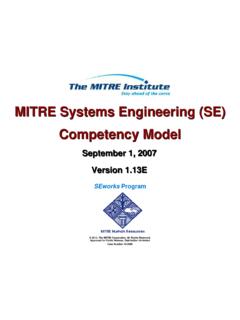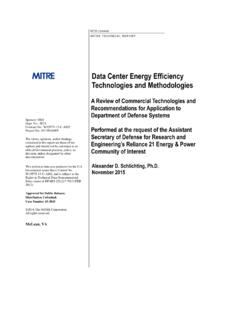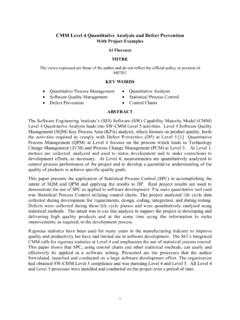Transcription of MITRE ATT&CK™: Design and Philosophy - Mitre Corporation
1 MP180360. MI TR E P R O D U C T. MITRE ATT&CK : Design and Philosophy Project No.: 01 ADM105-PI. The views, opinions and/or findings contained in this report are those of The MITRE Corporation and should not be construed as an official government position, policy, or decision, unless designated by other documentation. Approved for Public Release. Distribution unlimited 18-0944-11. 2018 The MITRE Corporation . All rights reserved. McLean, VA. Authors: Blake E. Strom Andy Applebaum Doug P. Miller Kathryn C. Nickels Adam G. Pennington Cody B. Thomas July 2018. Abstract The MITRE ATT&CK knowledgebase describes cyber adversary behavior and provides a common taxonomy for both offense and defense. It has become a useful tool across many cyber security disciplines to convey threat intelligence, perform testing through red teaming or adversary emulation, and improve network and system defenses against intrusions. The process MITRE used to create ATT&CK, and the Philosophy that has developed for curating new content, are critical aspects of the work and are useful for other efforts that strive to create similar adversary models and information repositories.
2 Iii 2018 The MITRE Corporation . All Rights Reserved Approved for Public Release. Distribution unlimited 18-0944-11. This page intentionally left blank. iv 2018 The MITRE Corporation . All Rights Reserved Approved for Public Release. Distribution unlimited 18-0944-11. executive summary This paper discusses the motivation behind the creation of ATT&CK, the components described within it, its Design Philosophy , how the project has progressed, and how it can be used. It is meant to be used as an authoritative source of information about ATT&CK as well as a guide for how ATT&CK is maintained and how ATT&CK-based knowledge bases are created for new technology-domains and platforms. v 2018 The MITRE Corporation . All Rights Reserved Approved for Public Release. Distribution unlimited 18-0944-11. Preface This paper documents the published version of ATT&CK as of April 2018. MITRE has announced plans to evolve and expand ATT&CK throughout 2018 [1]. This paper will be maintained as a living document and will be updated as significant changes are made to ATT&CK and the process used to maintain the content within ATT&CK.
3 Vi 2018 The MITRE Corporation . All Rights Reserved Approved for Public Release. Distribution unlimited 18-0944-11. Table of Contents Introduction .. 1. Background and History .. 1. ATT&CK Use Cases .. 3. The ATT&CK Model .. 5. The ATT&CK Matrix .. 5. Technology Domains .. 6. Tactics .. 7. Techniques .. 7. Technique Object Structure .. 7. Groups .. 10. Group Object Structure .. 10. Software .. 11. Software Object Structure .. 11. ATT&CK Object Model Relationships .. 12. The ATT&CK Methodology .. 14. Conceptual .. 14. Adversary's 14. Empirical 15. Sources of Information .. 15. Un(der)reported 15. Abstraction .. 15. Tactics .. 17. Techniques .. 17. What Makes a 17. Naming .. 17. Types of Technique 18. Technical References .. 18. Adversary Use .. 18. Technique 19. Creating New Techniques .. 20. Enhancing Existing Techniques .. 21. Named Adversary Groups Using 21. vii 2018 The MITRE Corporation . All Rights Reserved Approved for Public Release. Distribution unlimited 18-0944-11.
4 Incorporation Threat Intelligence on Groups and Software within ATT&CK .. 21. Ungrouped Use of Techniques .. 22. Examples of Applying the Methodology for New Techniques .. 22. summary .. 26. References .. 27. viii 2018 The MITRE Corporation . All Rights Reserved Approved for Public Release. Distribution unlimited 18-0944-11. List of Figures Figure 1. The ATT&CK for enterprise Matrix .. 6. Figure 3. ATT&CK Model Relationships .. 12. Figure 4. ATT&CK Model Relationships Example .. 13. Figure 5. Abstraction Comparison of Models and Threat Knowledge Databases .. 16. ix 2018 The MITRE Corporation . All Rights Reserved Approved for Public Release. Distribution unlimited 18-0944-11. List of Tables Table 3. ATT&CK Technology Domains .. 7. Table 4. ATT&CK Technique Model .. 8. Table 5. ATT&CK Group Model .. 10. Table 6. ATT&CK Software Model .. 11. x 2018 The MITRE Corporation . All Rights Reserved Approved for Public Release. Distribution unlimited 18-0944-11. This page intentionally left blank.
5 Xi 2018 The MITRE Corporation . All Rights Reserved Approved for Public Release. Distribution unlimited 18-0944-11. Introduction MITRE 's Adversarial Tactics, Techniques, and Common Knowledge (ATT&CK) is a curated knowledge base and model for cyber adversary behavior, reflecting the various phases of an adversary's attack lifecycle and the platforms they are known to target. ATT&CK originated out of a project to enumerate and categorize post-compromise adversary tactics, techniques and procedures (TTPs) against Microsoft Windows systems to improve detection of malicious activity. It has since grown to include Linux and MacOS , and has expanded to cover pre- compromise tactics and techniques, and technology-focused domains like mobile devices. At a high-level, ATT&CK is a behavioral model that consists of the following core components: Tactics, denoting short-term, tactical adversary goals during an attack (the columns);. Techniques, describing the means by which adversaries achieve tactical goals (the individual cells).
6 Documented adversary usage of techniques and other metadata (linked to techniques). ATT&CK is not an exhaustive enumeration of attack vectors against software. Other MITRE . efforts such as CAPEC [2] and CWE [3] are more applicable to this use case. Background and History ATT&CK was created out of a need to systematically categorize adversary behavior as part of conducting structured adversary emulation exercises within MITRE 's Fort Meade Experiment (FMX) research environment. Established in 2010, FMX provided a living lab capability that allowed researchers access to a production enclave of the MITRE corporate network to deploy tools, test, and refine ideas on how to better detect threats. MITRE began researching data sources and analytic processes within FMX for detecting advanced persistent threats (APTs). more quickly under an assume breach mentality. Cyber game exercises were conducted on a periodic basis to emulate adversaries within the heavily sensored environment and hunting was performed to test analytic hypotheses against the data collected.
7 The goal was to improve post- compromise detection of threats penetrating enterprise networks through telemetry sensing and behavioral analytics [4]. The primary metric for success was How well are we doing at detecting documented adversary behavior? To effectively work towards that goal, it proved useful to categorize observed behavior across relevant real-world adversary groups and use that information to conduct controlled exercises emulating those adversaries within the FMX. environment. ATT&CK was used by both the adversary emulation team (for scenario development) and the defender team (for analytic progress measurement), which made it a driving force within the FMX research. The first ATT&CK model was created in September 2013 and was primarily focused on the Windows enterprise environment. It was further refined through internal research and development and subsequently publicly released in May 2015 with 96 techniques organized under 9 tactics. Since then, ATT&CK has experienced tremendous growth based on contributions from the cybersecurity community.
8 Based on the methodology used to create the first ATT&CK model, a complementary knowledge base called PRE-ATT&CK was created to focus on left of exploit behavior, and ATT&CK for Mobile was created to focus on behavior 1. 2018 The MITRE Corporation . All Rights Reserved Approved for Public Release. Distribution unlimited 18-0944-11. in the mobile-specific domain. As of April 2018, enterprise ATT&CK now includes 219. techniques across Windows, Linux, and Mac. 2. 2018 The MITRE Corporation . All Rights Reserved Approved for Public Release. Distribution unlimited 18-0944-11. ATT&CK Use Cases Adversary Emulation The process of assessing the security of a technology domain by applying cyber threat intelligence about specific adversaries and how they operate to emulate that threat. Adversary emulation focuses on the ability of an organization to verify detection and/or mitigation of the adversarial activity at all applicable points in their lifecycle. ATT&CK can be used as a tool to create adversary emulation scenarios to test and verify defenses against common adversary techniques.
9 Profiles for specific adversary groups can be constructed out of the information documented in ATT&CK (see Cyber Threat Intelligence use case). These profiles can also be used by defenders and hunting teams to align and improve defensive measures. Red Teaming Applying an adversarial mindset without use of known threat intelligence for the purpose of conducting an exercise. Red teaming focuses on accomplishing the end objective of an operation without being detected to show mission or operational impact of a successful breach. ATT&CK can be used as a tool to create red team plans and organize operations to avoid certain defensive measures that may be in place within a network. It can also be used as a research roadmap to develop new ways of performing actions that may not be detected by common defenses. Behavioral Analytics Development By going beyond traditional indicators of compromise (IoCs) or signatures of malicious activity, behavioral detection analytics can be used to identify potentially malicious activity within a system or network that may not rely on prior knowledge of adversary tools and indicators.
10 It is a way of leveraging how an adversary interacts with a specific platform to identify and link together suspicious activity that is agnostic or independent of specific tools that may be used. ATT&CK can be used as a tool to construct and test behavioral analytics to detect adversarial behavior within an environment. The Cyber Analytics Repository1 (CAR) is one example of analytic development that could be used as a starting point for an organization to develop behavioral analytics based on ATT&CK. Defensive Gap Assessment A defensive gap assessment allows an organization to determine what parts of its enterprise lack defenses and/or visibility. These gaps represent blind spots for potential vectors that allow an adversary to gain access to its networks undetected or unmitigated. ATT&CK can be used as a common behavior-focused adversary model to assess tools, monitoring, and mitigations of existing defenses within an organization's enterprise . The identified gaps are useful as a way to prioritize investments for improvement of a security program.









